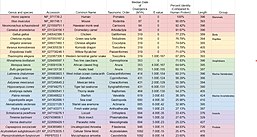Biology:C17orf75
Chromosome 17 open reading frame 75 is a protein that in humans is encoded by the C17orf75 gene. [1] C17orf75 is also known as SRI2 (sensitization to ricin complex subunit 2) and is a human protein encoding gene located at 17q11.2 on the complementary strand.[2] The protein this gene encodes is also known as NJMU-R1.[3] The C17orf75 gene is ubiquitously expressed at medium-low levels throughout the body and at slightly higher levels in the brain and testes.[4] This protein is thought to be part of a complex associated with golgin-mediated vesicle capture.[5]
Gene
The C17orf75 gene spans from position 32,328,441 to position 32,342,173 with a length of 13,733 nucleotides. The length after intron excision is 4,547 nucleotides, and the coding sequence is 1,191 nucleotides in length. C17orf75 has 10 exons.[6]
RNA
C17orf75 has 4 transcript isoforms: C17orf75 and 3 predicted isoforms which are C17orf75 transcript variant X1 (4,568 nucleotides in length), C17orf75 transcript variant X2 (4,449 nucleotides in length), and C17orf75 transcript variant X3 (4,464 nucleotides in length).
Protein
Structure

The primary isoform of the protein NJMU-R1 is 396 amino acids long. The theoretical isoelectric point for the protein NJMU-R1 is around 5, and its predicted molecular weight is around 44 kD.[9] This protein has a leucine zipper that is predicted to contribute to a coiled coil in the protein's folded structure.[10] The secondary structure of the protein is predicted to dominated by helices, with some beta sheets.[11] 3 potential disulfide bridge sites via cysteine residues are predicted in the protein.[12]
Post-Translational Modifications
The protein NJMU-R1 has two experimentally determined serine phosphorylation sites near the N-terminus.[13] Predicted post-translational modifications include tyrosine sulfation,[14] O-linked glycosylation,[15] and GPI anchor attachment.[16]
Tissue Localization
Immunohistochemistry staining images show moderate protein levels throughout mouse brain tissues, but the Purkinje layer in the cerebellum shows a distinctly high level of protein concentration, especially as compared to the neighboring granular layer. There are also high protein concentrations in the circumventricular organs of the mouse brain.[8]
Cellular Localization
Within the cell, images have shown the protein to be clustered in the cytosol and near the Golgi apparatus.[17] The PSORTII tool also predicts that this protein is localized to the cytosol.[10]
Expression Data
RNA sequencing data shows that C17orf75 is expressed highly in the testes, brain, and at moderately elevated levels in the kidney and thyroid.[4] Microarray data shows that this gene is expressed ubiquitously in most tissues, with moderate-to-high expression in the brain and testes and moderate-to-low expression in all other tissues.[18]
Expression levels of C17orf75 are seen to be higher in colorectal[19] and other cancers,[20][21] suggesting that C17orf75 may be a protooncogene or that there is another element of the gene's regulation that is causing these elevated levels.

Homology
The C17orf75 gene has orthologs as distantly related as amoeba and slime molds that are approximately 1,092,000,000 years old. It is seen in most animals that diverged since then, such as insects, though, notably, not Drosophila, marine vertebrates, marine invertebrates, 14 amphibians (only frogs/toads and caecilians), reptiles, birds, and mammals.
Protein Interactions
Research findings show that NJMU-R1 is predicted to be part of a trimer (with FAM91A1 [Family With Sequence Similarity 91 Member A1] and SRI1), as elicited through immunoprecipitation, fractionation, and mass spectrometry. This trimer has been proposed to promote the Golgi’s capture of vesicles, particularly vesicles involved with the AB toxin, ricin, as knockouts of C17orf75 lead to higher cell susceptibility to ricin.[22]
References
- ↑ "Entrez Gene: Chromosome 17 open reading frame 75". http://www.ncbi.nlm.nih.gov/gene/64149. Retrieved 2022-07-28.
- ↑ "C17orf75 chromosome 17 open reading frame 75 [Homo sapiens (human) - Gene - NCBI"]. https://www.ncbi.nlm.nih.gov/gene/64149.
- ↑ "C17orf75 Gene - GeneCards | NJMU Protein | NJMU Antibody". https://www.genecards.org/cgi-bin/carddisp.pl?gene=C17orf75&keywords=c17orf75.
- ↑ 4.0 4.1 "C17orf75 chromosome 17 open reading frame 75 [Homo sapiens (human) - Gene Expression - NCBI"]. https://www.ncbi.nlm.nih.gov/gene/64149#gene-expression.
- ↑ Navarro Negredo, Paloma; Edgar, James R.; Manna, Paul T.; Antrobus, Robin; Robinson, Margaret S. (2018-02-09). "The WDR11 complex facilitates the tethering of AP-1-derived vesicles" (in en). Nature Communications 9 (1): 596. doi:10.1038/s41467-018-02919-4. ISSN 2041-1723. PMID 29426865. Bibcode: 2018NatCo...9..596N.
- ↑ "C17orf75 chromosome 17 open reading frame 75 [Homo sapiens (human) - Genomic Regions - NCBI"]. https://www.ncbi.nlm.nih.gov/gene/64149#genomic-regions-transcripts-products.
- ↑ Ren, Jian; Wen, Longping; Gao, Xinjiao; Jin, Changjiang; Xue, Yu; Yao, Xuebiao (January 20, 2009). "DOG 1.0: illustrator of protein domain structures" (in en). Cell Research 19 (2): 271–273. doi:10.1038/cr.2009.6. ISSN 1748-7838. PMID 19153597.
- ↑ 8.0 8.1 "Brain tissue expression of C17orf75 - Summary - The Human Protein Atlas". https://www.proteinatlas.org/ENSG00000108666-C17orf75/brain.
- ↑ "protein Njmu-R1 [Homo sapiens - Protein - NCBI"]. https://www.ncbi.nlm.nih.gov/protein/NP_071739.2.
- ↑ 10.0 10.1 "PSORTII Tool". https://psort.hgc.jp/cgi-bin/runpsort.pl.[yes|permanent dead link|dead link}}]
- ↑ "I-TASSER server for protein structure and function prediction". https://zhanggroup.org/I-TASSER/.
- ↑ Ferre, F.; Clote, P. (2006-07-01). "DiANNA 1.1: an extension of the DiANNA web server for ternary cysteine classification". Nucleic Acids Research 34 (Web Server): W182–W185. doi:10.1093/nar/gkl189. ISSN 0305-1048. PMID 16844987. PMC 1538812. http://dx.doi.org/10.1093/nar/gkl189.
- ↑ "C17orf75 (human)". https://www.phosphosite.org/proteinAction?id=18866&showAllSites=true.
- ↑ "ExPASy - Sulfinator". https://web.expasy.org/cgi-bin/sulfinator/sulfinator.pl.
- ↑ "NetOGlyc - 4.0 Tool" (in en). https://services.healthtech.dtu.dk/.
- ↑ "GPI Prediction Server". https://mendel.imp.ac.at/gpi/cgi-bin/gpi_pred.cgi.
- ↑ "Subcellular - C17orf75 - The Human Protein Atlas". https://www.proteinatlas.org/ENSG00000108666-C17orf75/subcellular.
- ↑ "GDS596 Large-scale analysis of the human transcriptome". https://www.ncbi.nlm.nih.gov/geo/tools/profileGraph.cgi?ID=GDS596:203830_at.
- ↑ "GDS4382 Colorectal cancer tumors". https://www.ncbi.nlm.nih.gov/geo/tools/profileGraph.cgi?ID=GDS4382:203830_at.
- ↑ Chakraborty, Sanjukta; Khare, Sonal; Dorairaj, Syril Kumar; Prabhakaran, Venkatesh C.; Prakash, D. Ravi; Kumar, Arun (September 2007). "Identification of genes associated with tumorigenesis of retinoblastoma by microarray analysis". Genomics 90 (3): 344–353. doi:10.1016/j.ygeno.2007.05.002. ISSN 0888-7543. PMID 17604597.
- ↑ Chakraborty, Sanjukta; Nagashri, M. N.; Mohiyuddin, S. M. Azeem; Gopinath, K. S.; Kumar, Arun (February 18, 2011). "Gene Expression Profiling of Oral Squamous Cell Carcinoma by Differential Display RT-PCR and Identification of Tumor Biomarkers". Indian Journal of Surgical Oncology 1 (4): 284–293. doi:10.1007/s13193-011-0054-x. ISSN 0975-7651. PMID 22693380. PMC 3244262. http://dx.doi.org/10.1007/s13193-011-0054-x.
- ↑ Navarro Negredo, Paloma; Edgar, James R.; Manna, Paul T.; Antrobus, Robin; Robinson, Margaret S. (2018-02-09). "The WDR11 complex facilitates the tethering of AP-1-derived vesicles" (in en). Nature Communications 9 (1): 596. doi:10.1038/s41467-018-02919-4. ISSN 2041-1723. PMID 29426865. Bibcode: 2018NatCo...9..596N.
 |


